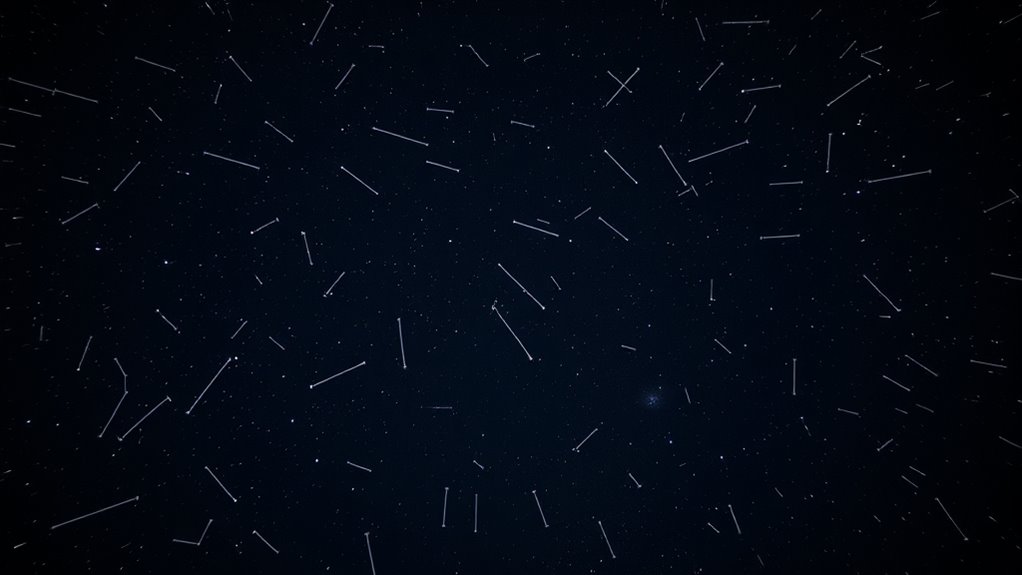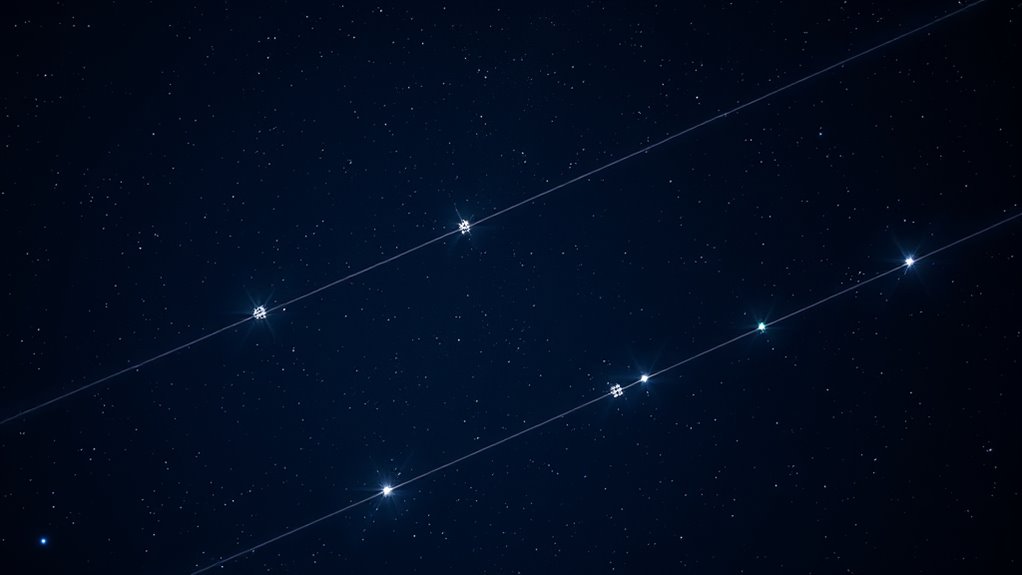Satellite constellations pose a serious threat to the night sky’s clarity. As more satellites are launched, they increase space debris, raise collision risks, and cause bright reflections that wash out stars and faint objects. This clutter makes astronomical observations harder and reduces visibility for amateur stargazers. While there are efforts to mitigate these issues, the sky’s pristine look could become permanently altered. To understand how ongoing technology and regulation efforts might help, keep exploring this important topic.
Key Takeaways
- Satellite constellations increase space debris, raising collision risks and potentially generating more debris that cloud astronomical observations.
- Bright reflections from satellites cause streaks and flashes in telescope images, impairing data quality and sky clarity.
- The proliferation of satellites heightens light pollution, making it harder to observe faint celestial objects from the ground.
- Efforts are underway to develop mitigation strategies like brightness adjustments and tracking, but challenges remain.
- Balancing satellite deployment with preserving a clear night sky requires coordinated global policies and technological innovations.

Have you ever wondered how the rapid growth of satellite constellations impacts our view of the night sky? As companies deploy hundreds or even thousands of satellites to provide global internet coverage, the effects on astronomy become increasingly apparent. One major concern is space debris. With so many objects orbiting close together, the risk of collisions rises, creating more debris that can threaten both operational satellites and the safety of space missions.
The rise of satellite constellations increases space debris and collision risks, threatening both satellites and space mission safety.
This accumulation makes the sky cluttered with fragments that can interfere with astronomical observations, especially when telescopes try to peer into distant galaxies or hunt for faint celestial objects. When debris reflects sunlight, it can cause unpredictable flashes and streaks in images, complicating the work of astronomers who rely on pristine data.
Another critical issue tied to satellite constellations is light pollution. While these satellites are primarily designed to be as unobtrusive as possible, their brightness can still be problematic. During certain times, especially shortly after launch or during specific orbits, satellites reflect sunlight directly toward Earth, creating bright trails across the sky.
These reflections can drown out the faint light from stars, planets, and other celestial phenomena, severely diminishing the quality of nighttime observations. For astronomers, this means fewer clear nights and more difficulty capturing accurate data. It’s not just a matter of aesthetics; the increased light pollution from satellite reflections hampers scientific research, making it harder to study the universe’s most subtle features.
The proliferation of satellite constellations also raises questions about the future of amateur astronomy. Many enthusiasts enjoy stargazing from their backyards, but as the number of visible satellites grows, their views become increasingly obstructed. Long-exposure photographs can show bright, moving streaks that ruin what should be a clear, dark sky.
This shift impacts educational and recreational activities, as well as citizen science projects that depend on accessible, dark skies.
While satellite operators and astronomers are working together to find solutions—such as adjusting satellite brightness, designing less reflective surfaces, and developing better tracking and mitigation techniques—the balance remains delicate. The rapid expansion of satellite constellations presents undeniable challenges, but addressing them requires coordinated effort.
Furthermore, understanding the space environment and how debris interacts with other objects in orbit is essential for developing effective mitigation strategies.
If not, the night sky’s clarity, once a universal window into the cosmos, risks becoming obscured by space debris and light pollution, diminishing our ability to explore and understand the universe.
Frequently Asked Questions
How Do Satellite Constellations Impact Amateur Stargazing?
Satellite constellations markedly impact your amateur stargazing by increasing space debris, which can clutter the skies and interfere with your observations. These satellites also cause telescope interference, making it harder to see faint stars and celestial objects clearly.
As more satellites launch, you’ll notice brighter streaks and less detail in your images. Staying informed about satellite activity and using advanced filters can help mitigate some of these challenges.
Are There International Regulations Addressing Satellite Debris?
You might wonder if international rules cover space debris. Currently, there are some regulatory frameworks aimed at managing space debris, like guidelines from the UN Office for Outer Space Affairs. These set standards for satellite end-of-life procedures and collision avoidance.
However, enforcement varies, and many countries are working to strengthen these regulations to prevent more debris, helping keep the night sky clearer for everyone.
Can Satellite Technology Be Modified to Reduce Sky Interference?
You can help reduce sky interference by advocating for improved satellite design that minimizes light pollution and signal disruption.
Modifying satellites to better track and deorbit orbital debris guarantees fewer hazards and less clutter in the night sky.
Advances in technology allow for easier adjustments, making future satellites more eco-friendly and less intrusive.
Your support for these innovations can help keep the sky clear and preserve our view of the stars.
What Future Advancements Might Mitigate Light Pollution From Satellites?
Future fixes focus on fostering formidable features like orbital shielding to fend off flashing satellites and facilitate light pollution mitigation. You might see smarter satellite systems that self-adjust brightness or employ innovative coatings to lessen luminosity.
Advances in orbital management could minimize clutter, curbing celestial chaos. These developments aim to diminish digital dazzle, helping astronomers and stargazers see the stars more clearly, ensuring the night sky remains a natural, navigable wonder.
How Do Satellite Launches Affect Existing Astronomy Research?
You might notice that satellite launches increase orbital congestion, making it harder for astronomers to observe distant objects clearly.
The debris from launches can also pose risks to telescopes and other equipment.
To protect astronomy research, space agencies focus on debris mitigation strategies, which help prevent collisions and reduce clutter in orbit.
These efforts aim to preserve the night sky’s clarity while supporting the growing demand for satellite services.
Conclusion
Balancing satellite constellations with astronomy is like tending a delicate garden—you want to enjoy the stars without overcrowding the night sky. If we work together, adjusting satellite designs and launch plans, we can preserve the celestial canvas for future stargazers. By being mindful, we guarantee the night sky remains a breathtaking masterpiece, not a crowded canvas filled with bright dots. After all, the universe’s beauty is a gift we should cherish and protect.










